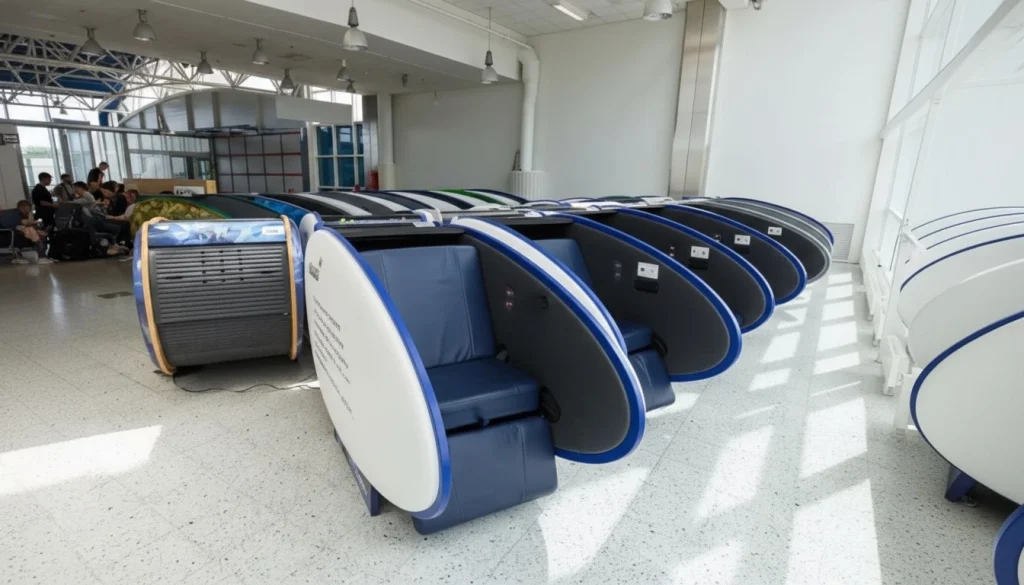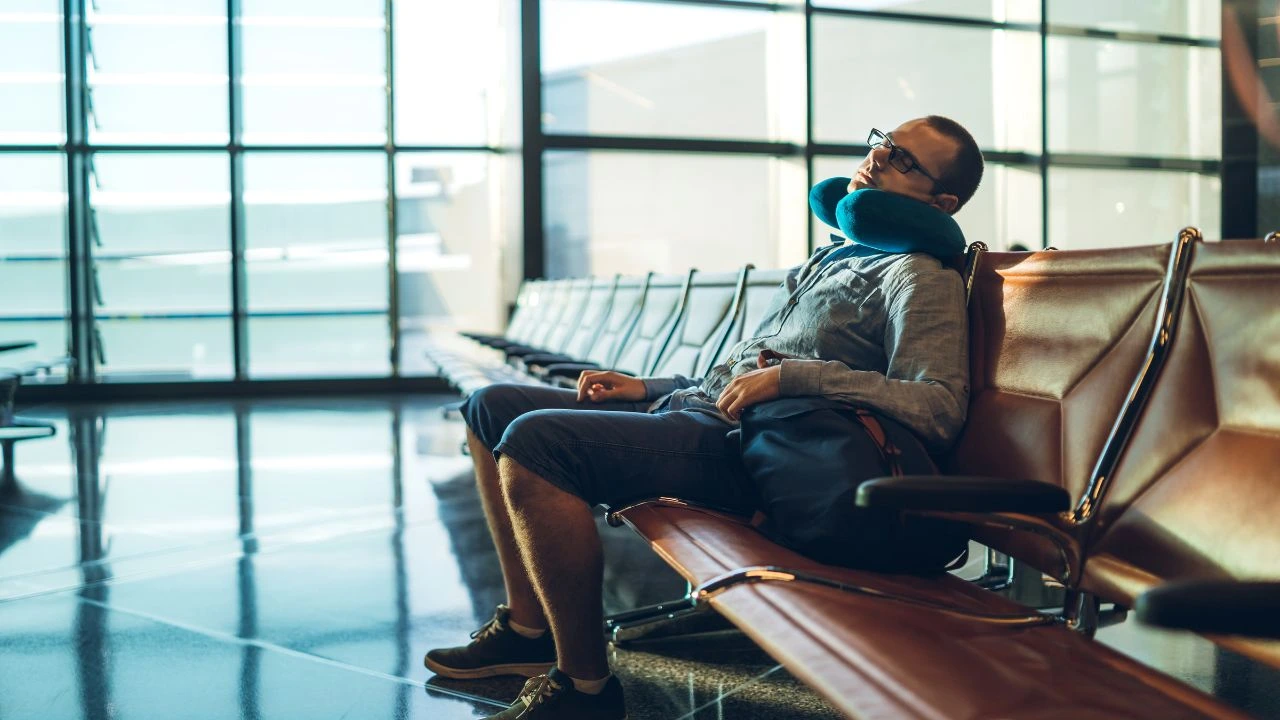What Is a Layover?
A layover is the waiting period between connecting flights at an airport before reaching your final destination. Layovers typically range from 60 minutes to overnight stays. According to the Bureau of Transportation Statistics, approximately 20% of domestic flights involve at least one connection, making layover management an essential travel skill.
How Long Should a Layover Be?
Minimum recommended layover times:
- Domestic connections: 60-90 minutes
- International connections: 2-3 hours
- Different terminals: Add 30-60 minutes
- Customs/immigration: Add 60-90 minutes
The Transportation Security Administration (TSA) recommends building in extra time for security screening, especially during peak travel periods.
Airport Sleeping Pods

Airport sleeping pods are private, rentable spaces designed for rest during layovers. These compact rooms typically include:
- Daybed or reclining chair
- Door or privacy screen
- Power outlets and USB charging
- Wi-Fi access
- Controlled lighting and temperature
- Some locations offer shower access
Major US airports with sleeping pods include:
- New York: JFK Terminal 4 & 5, LaGuardia Terminal B
- Atlanta (ATL): Concourses B, T, and F
- Dallas-Fort Worth (DFW): Terminals A, B, and D
- Houston (IAH): Terminals C and E
- Denver (DEN): Concourse C
- Chicago O’Hare (ORD): Terminal 3
- Miami (MIA): Concourse D
- Phoenix (PHX): Terminal 4
- Seattle (SEA): Concourse C
- San Francisco (SFO): Terminal 3
- Los Angeles (LAX): Terminal 1 and TBIT
How Much Do Airport Sleep Pods Cost?
Airport sleeping pod rates typically range from $30-$55 per hour, with discounts available for:
- Multi-hour bookings (often 10-20% off)
- Overnight stays (6+ hours)
- Advance reservations
Popular providers include Minute Suites, Sleepbox, and GoSleep. Most accept online booking through their apps or websites, though walk-up availability depends on occupancy.
Pro tip: Don’t trust just one alarm. Miss the connection and that nap won’t be worth it.
Airport Sleeping Pods vs. Lounges vs. HotelsByDay.com
| Feature | Sleep Pods | Airport Lounges | HotelsByDay.com |
|---|---|---|---|
| Best for | Private rest near gates | Food, drinks, WiFi | Deep sleep, full shower |
| Privacy | High (private room) | Low to medium | High (private room) |
| Sleep quality | Good (recliner/daybed) | Fair (chairs) | Excellent (real bed) |
| General Cost | $30-55/hour | $25-75 entry | $50-150/day |
| Location | Inside airport | Inside airport | Outside airport |
| Time needed | 1-4 hours | 1-6 hours | 4-12 hours |
HotelsByDay is redefining daytime stays.
Airport Lounge Access Options
Access airport lounges through:
- Premium credit cards – American Express Platinum, Chase Sapphire Reserve
- Airline status – Elite frequent flyer tiers
- Day passes – $25-75 via LoungeBuddy or Priority Pass
- Premium tickets – Business or first class
- Membership programs – Priority Pass ($99+ annually)
Most lounges offer complimentary snacks, beverages, Wi-Fi, charging stations, and sometimes showers. Check whether your lounge is landside (before security) or airside (after security) to avoid unnecessary security re-screening.
Day-Use Hotel Rooms for Long Layovers
For layovers exceeding 6 hours, consider booking a hotel room by the hour. Day stays near airports provide:
- Private room with real mattress
- Full bathroom and shower
- Climate control
- Quiet environment away from airport noise
- Often includes breakfast or snacks
HotelsByDay specialize in flexible hourly daytime hotel rentals near airports. Expect to pay $50-150 for a 3-8 hour block.
Learn more about what a day use hotel is.
Time calculation: Allow 45-90 minutes each way for airport exit, transportation, hotel check-in/out, and security re-entry. This makes day-use hotels practical only for layovers of 6+ hours.
Essential Layover Survival Kit
Pack these items in your carry-on for maximum comfort:
Personal care:
- Travel-size toiletries (TSA-compliant)
- Face wipes and hand sanitizer
- Toothbrush and toothpaste
- Deodorant
- Clean underwear and socks
- Eye mask and earplugs
Technology:
- Phone charger and cables
- Portable power bank (10,000+ mAh)
- Universal adapter for international layovers
- Headphones (preferably noise-canceling)
Comfort items:
- Neck pillow or inflatable pillow
- Light jacket or large scarf (doubles as blanket)
- Compression socks for circulation
- Refillable water bottle
- Healthy snacks
Can You Leave the Airport During a Layover?
Yes, but only with sufficient time. General guidelines:
Minimum layover times to leave airport:
- Domestic layovers: 6+ hours
- International layovers: 8+ hours (if no visa required)
- With visa requirements: 10+ hours
Before leaving, verify:
- Visa or entry requirements for the country
- Airport re-entry and security wait times
- Transportation options and travel time to city
- Checked baggage policies (may need special retrieval)
- Flight delay history for your airline/route
Some major hubs offer organized layover city tours through programs like Singapore Airlines’ Singapore Stopover or Icelandair’s Iceland Stopover, which streamline the logistics.
Maximize Comfort During Long Layovers
Find Quiet Zones
Most airports have designated quiet areas away from gate announcements. Look for:
- Meditation or yoga rooms
- Religious chapels or reflection spaces
- Observation decks
- Airport art galleries or museums
- Low-traffic gate areas for later flights
Read traveler reviews about napping and recharging in day hotels
Stay Active
Combat stiffness and improve circulation:
- Walk terminal pathways (many airports mark walking routes with distances)
- Use airport yoga rooms (available at SFO, DFW, BNA, and others)
- Stretch in quiet zones
- Take stairs instead of escalators
Airport Spa Services
Treat layover time as “me time” with services like:
- Chair massages (15-30 minutes)
- Manicures and pedicures
- Facials and skincare treatments
- Barbershop or salon services
- Shoe shines
Look for XpresSpa, Be Relax, and other airport spa brands throughout US terminals.
Manage Your Layover Like a Pro
Monitor Flight Status Actively
- Download your airline’s mobile app for real-time gate change alerts
- Use FlightAware or Flightradar24 for comprehensive tracking
- Check departure boards every 45-60 minutes
- Sign up for text alerts for your connecting flight
- Note boarding time, not departure time (boarding typically closes 15-30 minutes before departure)
- Want to plan ahead? Check out day-use hotels with free Wi-Fi and parking
Navigate Multi-Connection Layovers
For complex itineraries with multiple connections:
- Download airport terminal maps before your trip
- Identify inter-terminal transport (trains, buses, walkways)
- Locate your connection gate immediately upon arrival
- Time your walk to the next gate (add 25% buffer)
- Identify backup gates if your flight is prone to gate changes
Checked Baggage Considerations
Most checked baggage transfers automatically between connecting flights. However:
- Long layovers (8+ hours): Some airlines allow temporary baggage claim with re-check
- International connections: May require baggage claim for customs inspection
- Different airlines: Confirm baggage transfer agreements
- Airport storage: Some hubs offer luggage storage services (LuggageHero, Bounce)
Airport-Specific Layover Tips
New York (JFK/LGA)
- Terminals are separate buildings; verify your terminal carefully
- Sleep pods available in JFK T4, T5; LGA Terminal B
- Allow extra time for inter-terminal travel
- TWA Hotel at JFK offers hourly room rates
Atlanta (ATL)
- Use the Plane Train between concourses (automated train)
- Minute Suites in Concourses B, T, and F
- One of the busiest airports; stay alert for gate changes
- Multiple lounge options across all concourses
Dallas-Fort Worth (DFW)
- Skylink train connects all terminals airside
- Confirm whether your rest option is landside or airside
- Terminal D has the most international connections
- Grand Hyatt DFW offers day-use rooms
Chicago O’Hare (ORD)
- Large airport; allow 20+ minutes between terminals
- Terminal 3 has Minute Suites
- Underground pedestrian tunnels connect terminals 1, 2, 3
- Yoga room in Terminal 3
Los Angeles (LAX)
- Inter-terminal transfers require specific shuttles or walks
- Choose rest options in your departure terminal
- Significant construction may extend walking times
- Limited airside connections between terminals
Frequently Asked Questions
Do all airports have sleeping pods?
No. Sleeping pods are primarily found in major US hubs and international airports. Smaller regional airports typically lack these facilities. Always verify availability before your trip by checking the airport’s official website or contacting sleep pod providers directly.
Are sleeping pods worth the cost?
For layovers of 3-6 hours where you need genuine rest, sleeping pods offer excellent value compared to leaving the airport for a hotel. The privacy, proximity to gates, and hourly flexibility make them cost-effective for mid-length layovers.
Can I shower during a layover?
Yes, shower facilities are available in many airports through:
- Airport lounges (most premium lounges include showers)
- Sleeping pod suites (some Minute Suites locations)
- Dedicated shower facilities (XpresSpa and other services)
- During your day stay with HotelsByDay near airports
Prices range from complimentary (with lounge access) to $10-25 for standalone shower services.
What if my layover is less than 2 hours?
For short layovers, prioritize reaching your next gate over comfort amenities. Verify your connecting gate immediately upon arrival, head straight there, and then explore nearby food or shopping options only if time permits.
How do I know if I have enough time to leave the airport?
Use this calculation:
- 30-60 minutes: Airport exit and transportation to city
- Your desired city exploration time
- 30-60 minutes: Return transportation
- 60-90 minutes: Airport re-entry and security screening
- 30-minute buffer for unexpected delays
If this total exceeds your layover by more than 90 minutes, consider staying airside.
What happens if I miss my connection?
If you miss your connection due to your first flight’s delay, airlines typically rebook you automatically on the next available flight at no additional cost. If you miss your connection due to leaving the airport or dawdling, you may need to purchase a new ticket or pay change fees.
Final Recommendations
Transform your long layover from frustrating downtime into productive recharge time:
For 1-3 hour layovers: Find comfortable seating near your gate, use airport Wi-Fi for work or entertainment, and grab food you’ll actually enjoy.
For 3-6 hour layovers: Book an airport sleeping pod for genuine rest, or access an airport lounge for food, drinks, and comfortable seating.
For 6-12 hour layovers: Consider a day-use hotel for deep sleep and a full shower or explore the city if entry requirements and timing align.
Pack your carry-on strategically, stay informed about flight changes, and plan your layover “home base” using airport maps. With these tools, even the longest airport waits become manageable—and sometimes even enjoyable.

